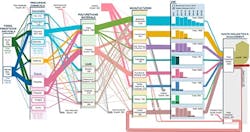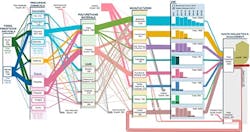Recycling: Polyurethane Requires A Rethink
The widespread use of polyurethane, which goes largely unrecycled, is generating concerns about its environmental impact in the United States. So, a team of researchers from Lemont, Ill.-based Argonne National Laboratory, part of the U.S. Department of Energy (DOE); Northwestern University, Evanston, Ill.; and The Dow Chemical Company, Midland, Mich., conducted a study to better understand polyurethane, its uses and recovery options, and plant-based alternatives to chemicals used in its production.
The study, recently published in the journal Environmental Science & Technology, provides a material flow analysis of the chemical through the U.S. economy, tracking back to fossil fuels and covering polyurethane-relevant raw materials, trade, output, manufacturing, uses, historical stocks, and waste management.
“The goal was to understand how linear versus how circular is our use of polyurethanes in the United States,” explains co-author Jennifer Dunn, associate director of Northwestern’s Center for Engineering Sustainability and Resilience and a member of the Program on Plastics, Ecosystems and Public Health at the Institute for Sustainability and Energy at Northwestern. “We also wanted to see if there are opportunities to enhance circularity and increase the bio-based content of polyurethanes.”
The researchers expected and confirmed a largely linear system.
The study highlighted a number of complexities that affect recoverability and recyclability, notes Troy Hawkins, who leads the Fuels and Products Group in Argonne’s Systems Assessment Center.
“Polyurethanes exist in various forms, from rigid to flexible, and each of these applications look and act differently. The use of polyurethanes has expanded rapidly in the last 50 years, and many uses are long-lived. So, what’s going in now may not come out of use for another 10, 20 or 30 years. And there’s an issue with the concentration of polyurethane in various applications. For example, an adhesive or sealant is much harder to separate and recover compared to a mattress or carpet padding,” he says.
Figure 1. This ‘panoramic view’ of polyurethane flow in the United States helped researchers identify opportunities and challenges for recycled/upcycled polyurethane and biobased polyurethane. Source: Environ. Sci. Technol. 2021, 55, 20, 14215-14224
Based on the flow analysis (Figure 1), the team discovered three main opportunities, along with challenges to each. First, ample feedstocks from waste could support increased polyurethane circularity. In particular, flexible foam is in high demand as a recycled feedstock. However, the current recycling rate for post-consumer waste is low, but secondary feedstocks (from waste) are abundant and could support polyurethane recycling.
The researchers report chemical recycling — which regenerates the materials’ chemical constituents — could reduce U.S. demand for polyols for polyurethane production and overcome limitations posed by mechanical recycling.
The team also found opportunities to use biomass as a feedstock for production of polyurethane, reducing demand for fossil fuels. Nearly all major types of polyurethane could incorporate greater amounts of biomass-derived precursors in their supply chain, which is especially important for types difficult to recycle, they say.
For next steps, Dunn says the team will use the study to help steer development of new chemistries that could lead to more recyclable, bio-based polyurethanes.
“The material flow analysis highlights opportunities where there are large amounts of waste material that could almost entirely supplant new production if the materials were recyclable. It is these products and chemistries that are most ripe for innovation. From the study we published, for example, it’s clear that the U.S. throws out more flexible foam than it produces (based on data from 2016). It’s advisable then to pursue chemistries that are used in flexible foams for ease of recycling,” explains Dunn.
“It’s going to be necessary for us and other researchers to keep contributing to this body of knowledge about these supply chains if we want to design a circular economy,” she adds.

